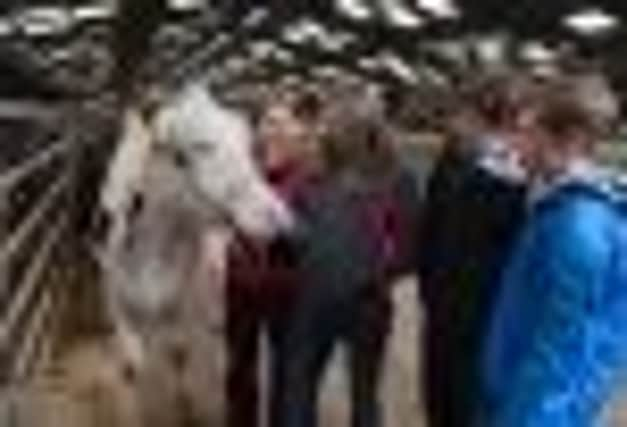High school pupils get a taste of life down on the farm


Ann Laird of Blyth BridgeFarm is showing off prize heifer Mavis, pointing out the wide-apart legs, the veiny udder, the flat silky rear, wide mouth and the long feminine neck which farmers prize in pedigree dairy animals.
Studying the finer points of Mavis are a group of geography students from Peebles High School on a field trip to the farm in a scheme which aims to bring young people face-to-face with the day-to-day world of farmers.
Advertisement
Hide AdAdvertisement
Hide AdLesley Mason, of the Royal Highland Education Trust, says: “We want children to know where their food comes from so they can make informed choices.”
Ann Laird’s mother, Kathleen, shows the pupils the huge amount of feed a cow has to consume in a day to produce 30 litres of milk. Her father Alister shows them the rotating milking parlour, which Laura Dennison of Innerleithen thinks looks like fun: “Like a carousel for cows.”
Teacher Lisa Conlan says the farm visit programme has been designed to complement the school curriculum: “All of these children have taken geography as an elective subject and rural life is one of the topics they cover.
“Some are from farms, but some of them have never been on a farm before. It is important to learn where their food comes from and how it impacts on the environment.”
The pupils are fascinated by the rotary milking parlour and goggle-eyed when they are given a bottle of fresh milk to hold and realise how warm it is when it comes out of the cow.
When they reach the shed housing the fluffy, disorientated newborn calves there is a chorus of “Aaaaaaaaahs”. With around 500 head of cattle, the farm commonly has two births a day. But even on a farm of this size the bond these Borders farmers have with their animals is clear.
Jumping into a pen at the side of the shed, Kathleen Laird helps a newborn animal to its feet and shows how the ears are tagged. “See? It doesn’t hurt,” she says, as the calf wobbles on its feet. She also shows pupils the pedigree certificate, which shows the name, birth time and parentage of each calf. And she takes time to test the pupils’ knowledge of the nutritional values of milk.
The hope of the trust is that these youngsters will grow up with a clearer sense of Scotland as a food-producing country.
Advertisement
Hide AdAdvertisement
Hide AdThe people behind the RHET scheme talk of a “lost generation” – a generation of young people who have no first-hand connection with agriculture and food production.
Re-establishing that link could not only help support Scottish agriculture but could improve the nation’s health as well. RHET manager Alison Motion said: “It is essential that the consumers of tomorrow understand the high quality of food from within Scotland. Learning how to read labels to ensure you are eating food grown in Scotland brings with it a quality seal that the farmers have worked hard to achieve and maintain.
“We always stress the high animal welfare standards we have when we take pupils outdoors on to farms and encourage them to question where their food comes from when they are back at home.”
By 2015 the goal is for every child to have some kind of hands-on educational experience of agriculture.
Rural affairs secretary Richard Lochhead said: “Food education is vital, and simple things like a visit to a farm can make a big difference – encouraging young people to learn more about these issues and helping them to understand exactly where food comes from and the role it plays in their lives.
“The Royal Highland Education Trust is doing great working organising food and farming days and I’m delighted that pupils across the country, including those from Peebles High School, are reaping the benefits.”
Also on the Borders farm visit is Sally Wilson, current national chairman of the Scottish Association of Young Farmers and herself a dairy farmer with 300 cattle. The young farmers are taking a leading role in supporting the educational programme and Wilson herself has welcomed groups of visitors to her farm.
With the horsemeat scandal leading to fears about contaminated supply chains, interest in local producers and local produce has never been greater.
Advertisement
Hide AdAdvertisement
Hide AdBut there is still a great deal of ignorance about the reality of farming and too much distance between farmers and the public at large.
Sally Wilson says: “Traditionally it isn’t something farmers are good at. There is a lot of fear about letting people in. But we are all incredibly proud of what we do.”
“What’s great is people are seeing what we can offer. We are really lucky in Scotland. We are a very rural nation, people are not that far removed from agriculture. And we are still a really foodie country.”
Ann Laird said her family enjoyed showing young people around the farm and sharing knowledge.
“We are amazed about how little people know. It is in your blood and you just think everybody knows what you know.”
After waving off the coach taking the youngsters back to school, Kathleen Laird says she thought today’s visit went well.
“You have to give them things they can relate to.
“We could clean everything up before they visit, but it is a working farm so it’s not all clean, it’s lived in. It’s real.”